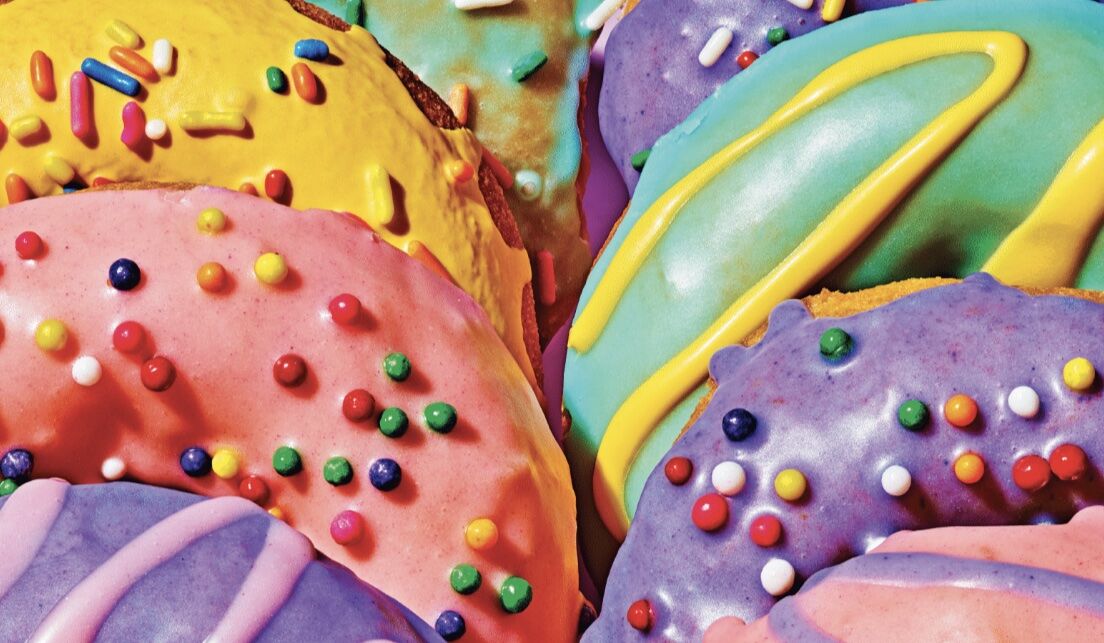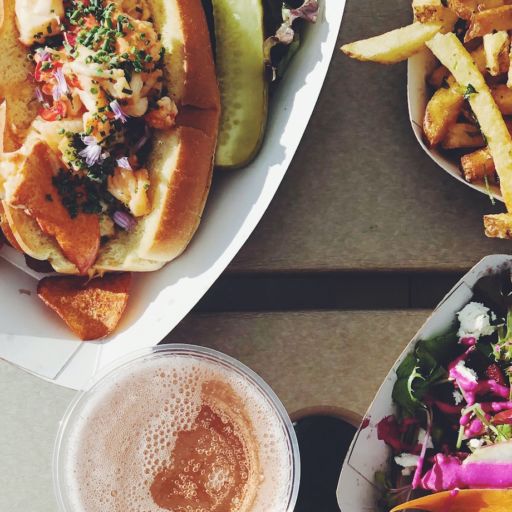This essay appears in The Food Issue, which is on sale here.
If one food type represents Los Angeles to me, it is the sweet and simple working-class delight known as a doughnut. Or “donut,” depending on the signage. Without a doubt, my favorite food and roadside staple of my favorite city. When I first moved to Los Angeles, I lived with my eldest brother by Venice Beach. At some point in those first months I dated a new friend’s ex-girlfriend, who lived all the way across town, in Silver Lake, the “Eastside” neighborhood my family later called home for over 14 years, coincidentally.
As a young man, it was nice to think that love (or something close to it—fate, perhaps) was guiding me. But it’s no surprise to me now that, having fled a suffocating social circle in Melbourne, Australia, for an enormous foreign city like Los Angeles, I simply hooked up with one of my friend’s exes, yet was fine traveling long distances to see her. They were the two things I knew: claustrophobic dating practices and distant journeys. Making life hard for yourself is so easy when you’re young.
Seeing my new flame required an almighty drive across this incomprehensibly large city. Having only recently arrived in town, it felt as if there was nothing in between the two distinct east and west sides of Los Angeles I was just getting to know. Only the cross-dimensional wonder of the 10 Freeway, a straight shot through the lives of millions, exhilaratingly fast at the right times of day and specifically designed to transport Angelenos from the sparkling waters of its coast to the twinkling lights of its hills. Seamlessly. At the turn of the 21st century, via the fabled odd- (for north-south) and even- (east-west) numbered freeways branching off “The Ten,” with a Thomas Guide map book on your lap, a tank of cheap gas in the car and a bag of donuts by your side, you could go anywhere in Los Angeles. Pretty fast, too.

Although often treated as a luxury accessory or fantasy self-image prop, a car is a necessity here. I would argue that our doughnut shops are, too. Where else in the world can you pull into a dingy minimall, in any neighborhood, enjoy free parking and buy a fresh-baked good, made that day, on the premises, for about a dollar? There are countless expensive restaurants without that kind of guarantee all over the city, and you better believe you’ll pay for parking. You may even suffer the indignity of watching an underpaid man in an ill-fitting, red nylon vest take your keys and park your car in the very lot upon which you are standing. Then at the completion of your meal, he’ll ask for full payment plus gratuity in cash before handing you the keys so that you may retrieve the car yourself.
Not at a doughnut shop. Never. Not even the new, fancy, four-dollar ones.
The doughnut is to America what so many great dough-based staples are to the rest of the world. For someone who likes to eat the same things often, I have always found comfort in a traditional, regional take on flour, water and heat.
In Mexico, I’ve spent the best part of a day sightseeing, mostly just trying to spot a churro vendor. In the right parts of Los Angeles you can find them, too, selling a bag of warm, skinny doughnut sticks, powdered in sugar and cinnamon, for as little as a buck or two.
The boulangeries of France are like dietary comfort stations, full of carefully prepared bundles of energy. Italy has pizza dough, in all its many incarnations. Greece, the pita. It’s almost hardwired into our brains to enjoy a freshly prepared serving of any of these flour-based staples. The humble loaf of bread alone is a western symbol for sustenance.
Even when someone with as white a dietary background as me is sat down in a serious Indian or Asian restaurant, not entirely sure of the dishes laid out before me, those saviors roti and naan bring an unexpected solace. Maybe the goat curry is a little much to take on, but dip some fresh roti in the sauce and a familiar connection is made. A cultural gateway magically opens.
Perhaps the only traditional Australian bread proves the point best. Damper, as it’s known, is said to have been adapted by the settlers from an Indigenous “bush bread,” originally made with crushed native seeds. With a consistency similar to traditional Irish soda bread, damper is just flour and water. Wrapped in foil—or for the purists, packed into the bottom of a billycan (a tin, multipurpose, Australian camp oven)—the dough is idly left in the ashes of a campfire as life goes on around it, long enough that tapping on the crust makes a hollow sound.
Compared to what even hobbyists will go through to create the perfect sourdough loaf, damper could not be more rudimentary. Set it and forget it. Still, pull that lump out of an open fire, cut off a corner, smother it with butter and whatever else you fancy and I can assure you it is an absolute delight. As nourishing to body and soul as a flaky pain au chocolat on the Champs-Élysées or a fresh donut on The Ten.
The kind of passion I have for doughnuts is not something I saw a lot of growing up. My family worked hard, it felt, to keep desires on an even keel. Affection was limited, outbursts almost unheard of, and caring too much about something represented a potential point of vulnerability, rather than an opportunity for connection. As a result, indulgences were more closeted than shared.
My mother always had a sweet tooth, and once as a child, while her parents were away, she convinced a live-in nanny to pack jelly crystal sandwiches in her school lunch. It lasted as long as she could stomach midday hits of white bread, butter and colored sugar between classes. About two weeks, by her recollection. Not bad.
As boys, my brothers and I each had our own clandestine little weaknesses. My middle brother was very partial to Boston buns, a cake-sized loaf embedded with raisins and smothered in coconut icing. Not unlike a giant donut. Traditionally, it was cut into slices and buttered, but he was happy to take on the whole thing if given the chance.
I also recall my eldest brother falling for an oversized chocolate eclair, sold only at the Melbourne International Airport for some reason. These were the days when you would go out to the airport as a family to see someone off, or welcome them back. On one occasion, he volunteered to come greet someone, only to excuse himself once inside the building to find the terminal with the eclair place. He located it and cradled his cream-filled, chocolate-covered patisserie home in its paper doily like a new pet.
On a school trip to Tasmania, my classmates and I visited the famous Cadbury chocolate factory, which had a store selling goods that didn’t pass Quality Control at a steep discount. I loaded up on Turkish Delights, packed them in my luggage, then stacked them in a bedroom closet. There I hoarded them for weeks, taking just a little at a time, long enough for their chocolate coating to bloom white and for me to lose interest. I hadn’t yet found my passion, and the doughnuts from the newly arrived 7-Eleven by our house were not only stale, but somehow wet and waxy, too. Pale, corporate imitations.
My mother’s sweet tooth, and her father’s before her, was almost undoubtedly what led me to doughnuts. My grandfather would pick up lamingtons (an Australian treat comprising squares of sponge cake, sometimes split in the middle and held together by a thin line of strawberry jam, rolled in melted chocolate and coconut shavings) for his kids from time to time, and my mother carried on the tradition by stopping at the doughnut van outside the local market after her weekly shopping trips. It was an early take on the now-popular food truck concept. In an old bus they turned out a particularly Australian take on the delicacy. Peering through the windows, you could watch perfectly crisped, rounded lumps of dough emerge from bubbling oil before being dumped in sugar and injected with raspberry jam so hot it would burn your tongue if you didn’t show patience. She didn’t pick up a bag every week, but it was the first thing I looked for when she pulled into the driveway, hoping to catch the scent wafting from inside her car. The same van often parked outside the homeground of our Australian rules football team and was half the reason I elected to go to games with my older brothers and father before I grew to love the game for what it is.

Doughnuts are not the healthiest favorite food, I will admit. But which of our passions are? As an old friend once said to me at dinner, “I wish I liked salad just a little bit more.” It’s not the sort of thing one falls head-over-heels for. I dread the day when my doctor surveys my yearly numbers, then gives me a gentle tap on the shoulder, followed by a quiet word about the Doughnuts like a baseball manager taking his opening pitcher out of the game. “That’s enough, son.”
Until then, I will enjoy every one of those fluffy wonders, and I’m afraid to say that I’m passing them down a generation, once more.
During the COVID pandemic, when everything was closed and normal indulgences limited, my children and I developed a new habit. They’re always hungry for snacks, and I’m bad at keeping something handy. But unlike most foods, I can happily eat a doughnut any old time of day, thank heaven, and the stores here barely ever close. Even in a global health crisis, some rare bureaucratic saint deemed them “essential.” So we would stop at a strip mall wherever we had driven to get out of the house and distract ourselves. I would mask up, go into the store and return with a small white bag, its paper almost immediately spotted with grease.
Deadly virus invisibly swirling around us, we all climbed into the tray of my truck. Beneath the tireless Los Angeles sun — my boy with his finger through a glazed ring, his sister face-first into pink frosting, and me carefully considering the quality of goods — we ate those little delights as one. Content for a moment. All for less than the cost of a gallon of gas, and enjoyed in as close to silence as a parent of children under 10 can hope for.
What a time to be alive.




